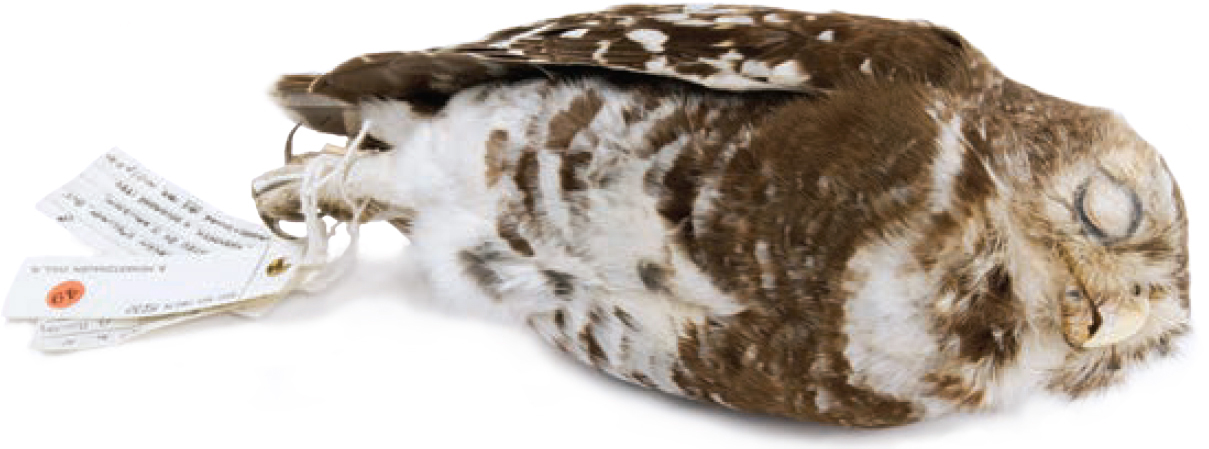29 : Meinertzhagen’s Forest Owlet specimen
1880
The Forest Owlet was perhaps the most notorious specimen stolen by eminent ornithologist Richard Meinertzhagen, who threw doubt onto his life’s work, much of which was probably sound, by his lack of discipline when it came to collecting bird specimens.
The rediscovery of the Forest Owlet in India in 1997 was greeted with widespread delight. This small diurnal owl of the Maharashtra region had previously been known from only seven specimens, including four collected in the same region by J Davidson between 1880 and 1883, and a last specimen claimed by Colonel Richard Meinertzhagen to have been collected in Gujarat, more than 500 miles away, just over 30 years later.
As some of Meinertzhagen’s specimens had been exposed as having been stolen and fraudulently relabelled, the scientists who rediscovered the owlet painstakingly examined his stuffed Forest Owlet which was housed in the Natural History Museum, Tring.
X-rays determined that the preparation of all the examples was identical, and it was also revealed that a fifth Davidson specimen had existed but was now missing. Meinertzhagen wasn’t in that region of India at the time he said he collected the bird, and never published anything on this extremely rare species. The specimen had almost certainly been stolen and added to the colonel’s own personal collection of 20,000 prepared bird skins.
In any hobby – or indeed in science – there are ways to profit. They can be financial, or involve gaining respect, giving the impression of authoritativeness or even feeling a sense of superiority over others. The science of ornithology and the pastime of birding have both always had room for discovery and earning plaudits. In tandem with the rise of private and museum collections of exotica came the ability to ‘pull the wool’ and profiteer.
Financial gain had the greatest influence from the 18th to the early 20th centuries, and in Britain this partly came from the desire of some wealthy collectors to possess the rarest British-caught specimens. Surprisingly, at the beginning of the 1700s, proof or assurance of the veracity of valuable specimens was far from common, and this enabled, for example, butterfly specimens to be passed off as ‘new species’ by the addition of ink or paint.
As brutally simple as such frauds appear, birds were initially harder to pass off as being genuinely caught in the British Isles. With exotic species being imported preserved in alcohol or as desiccated wings, heads and tails, it was difficult to defraud a potential customer. But after it was discovered that mixing salt with water could result in the ability to preserve specimens at temperatures well below freezing point and the transport of frozen food became common, fresh-looking specimens became easy to acquire in bulk.
By the late 19th century, the transport of frozen fish and poultry was taking place on an industrial scale. This was the likely background to the notorious Hastings Rarities scandal, in which the belated rejection of almost 600 records involving rare bird specimens took place after they were considered to be part of a conspiracy to make money by a local taxidermist called George Bristow, along with unknown or unnameable ornithologists and collectors, by importing foreign bird corpses in this manner. The number and location of the specimens made it highly unlikely that they were genuine, and it is damning that none of the other then numerous local taxidermists had anything like a similar selection of preserved birds for sale.
Self-aggrandisement can be an even greater motivator for deceit. This takes us full circle to Colonel Meinertzhagen, perhaps one of the most heroic ornithologists during the decline of the British Empire. Many of the tales of colonial derring-do on his part had, it later transpired, originated purely in the mind of the protagonist, who was also posthumously revealed to be an unpunished murderer, a thief and a cheat.
Through his career as collector, ornithologist, writer and vice-president of the BOU, he stole specimens from museums, relabelled them as his own and took credit for new discoveries. When specimens in the Tring collection were analysed for their taxidermy style, dates and locations of collection, many were found to be inconsistent and unlikely.
Acquisitive, amoral and impatient, Meinertzhagen’s self-indulgence has tainted the reputation and achievements of a man whose work was genuinely brilliant and ground-breaking (including discovering a genuine new species in Afghan Snowfinch). His dark double life has seen the posthumous undoing of most of his work.
With the recognition granted to the rarity finder in today’s birding scene, it is unsurprising to find that fraud continues and, when suspected, lack of concrete evidence enables many to get away with it. The most notorious rare bird fraud in Britain in recent years involved the fifth national record of a Hermit Thrush from North America, purportedly from Chipping Ongar, Essex, in October 1994. It was accepted by the Rarities Committee despite damning circumstantial evidence, and eventually revealed as a hoax by the submitter of the record, who unmasked himself in a confessional article some years later in Birdwatch magazine.
